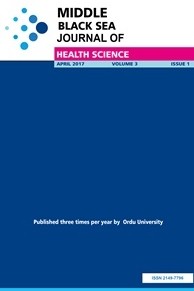A Retrospective Assessment of Specific Learning Disorders
A Retrospective Assessment of Specific Learning Disorders
Objective: Specific learning disorders (SLD) are delays or deviations observed in an individual’s ability to speak, read, write, understand and do arithmetic. Diagnosis and the educational process is very difficult. Abnormalities of the central nervous system are shown as the cause of SLD, in addition to hereditary and environmental interactions. SLD has four subareas of reading disorder (dyslexia), written comprehension disorder (dysgraphia), mathematic disorder (dyscalculia) and other types. SLD may be accompanied by attention deficit and hyperactivity disorder, depression, anxiety, emotional and social problems. Epidemiological research has found rates of 1-33%. The lack of clarity in SLD criteria with very different rates of diagnosis may be linked to the difficulties of diagnosis and method deficiencies. Studies have shown it is observed more often in males in terms of gender, with no significant correlation between females and males. This study aimed to retrospectively assess SLD diagnoses from 2009 to 2017. Methods: The study accessed data for all SLD children from 2009-2017 and included 846 child diagnoses in total.Results: The study found the percentage of a population of 201,347 people aged from 0-18 years containing 197 SLD cases was 0.09%. Single sample chi-square test observed a significant level of increase as the years passed. Additionally, in terms of gender, the incidence in males (69.14%) was higher than in females (30.85%). The increase in SLD according to year was identified to be significantly rapid. Conclusion: According to the data obtained in the study, it was concluded that there is a need for in-depth research into topics from SLD diagnosis to methods on a country basis.
Keywords:
Specific learning disorder, retrospective assessment increase rate of specific learning disorder,
___
- Asfuroglu BO, Fidan ST. Spesific learning disorders. Osmangazi Journal of Medicine, 2016; 38 (Special Issue 1): 49-54.
- Balci E. Facts about dyslexia: what is dyslexia and what is not? Trakya University Journal of Social Science 2017; 19(1): 1-17.
- Beitchman JH, Young AR. Learning disorders with a special emphasis on reading disorders: a review of the past 10 years. J Am Acad Child Adolesc Psychiatry 1997; 36: 1020-32.
- Beitchman JH, Adlaf EM, Douglas L, Atkinson L, Young A, Johnson CJ, et all. Comorbidity of psychiatric and substance use disorders in late adolescence: a cluster analytic approach. Am J Drug Alcohol Abuse 2001; 27: 421-40.
- Demonet JF, Taylor MJ, Chaix Y. Developmental dyslexia. Lancet 2004; 363: 1451-1460.
- Deniz ME, Yorgancı Z, Özyesil Z. A Research on Investigating the Trait Anxiety and Depression Levels of the Students with Learning Disabilities. Elementary Education Online. 2009; 8(3): 694-708.
- Fortes IS, Paula CS, Oliveria MC, Bordin IA, De Jesus Mari J, Rohde LA. A cross-sectional study to assess the prevalance of DSM-5 specific learning disorders in representative school samples from the second to sixth grade in Brazil. Eur Child Adolesc Psychiatry 2016; 25: 195-207.
- Görker I, Bozatlı L, Kormazlar Ü, Yücel Karadağ M, Ceylan C, Söğüt C, et. All. The Probable Prevalence and Sociodemographic Characteristics of Specific Learning Disorder in Primary School Children in Edirne. Arch Neuropsychiatr. 2017; 54: 343-349. DOI: 10.5152/npa.2016.18054:1-7.
- Hammill DD. On defining learning disabilities: an emerging consensus. J Learn Disabil 1990; 23: 74-84.
- Karaman D, Kara K, Durukan İ. Spesific learning disorders. Anatol J Clin Investig 2012; 6(4): 288-298.
- Kempe C, Gustafson S, Samuelsson S. A longitudinal study of early reading difficulties and subsequent problem behaviors. Scand J Psychol 2011; 52(3): 242-50.
- Moll K, Kunze S, Neuhoff N, Bruder J, Schulte-Körne G. Spesific Learning Disorder: Prevalance and Gender Differences. PLoS ONE 2014; 9: 1-8.
- ÖEHY, Özel Eğitim Hizmetleri Yönetmeliği, Devlet Bakanlığı ile Milli Eğitim Bakanlığından 31.05.2006 tarih ve 26184 sayılı Resmî Gazete. https://orgm.meb.gov.tr/meb_iys_dosyalar/2012_10/10111226_ozel_egitim_hizmetleri_yonetmeligi_son.pdf (Ulaşım: 02.04.2018).
- Özyürek, M. (2003). Öğrenme güçlüğü gösteren çocuklar. (Ed: A. Ataman) Özel Gereksinimli Çocuklar ve Özel Eğitime Giriş. Ankara: Gündüz Eğitim ve Yayıncılık.
- Polanczyk G, de Lima MS, Horta BL, Biederman J, Rohde LA. The worldwide prevalence of ADHD: a systematic review and metaregression analysis. Am J Psychiatry 2007; 164:942-948.
- Rutter M, Caspi A, Fergusson D, Horwood IJ, Goodman R, Maughan B, Moffitt TE, Meltzer H, Carroll J. Sex differences in developmental reading disability: new findings from 4 epidemiological studies. JAMA 2004; 291:2007-2012.
- Saenz LM, Fuchs LS, & Fuchs D. Peer- assisted learning strategies for English language learners with learning disability. Exceptional Children. 2005; 71(3): 231-247.
- Stevenson HW, Stigler JW, Lucker GW, Lee S, Hsu C, Kitamura S. Reading disabilities: the case of Chinese, Japanese and English. Child Dev 1982; 53: 1164-1181.
- Taanila A, Ebeling H, Tiihala M, Kaakinen M, Moilanen I, Hurtig T, Yliherva A. Association between childhood specific learning difficulties and school performance in adolescents with and without ADHD symptoms: a 16-year follow-up. J Atten Disord 2014; 18: 61-72.
- Torgesen JK, Dice C. Characteristics of research on learning disabilities. J Learn Disabil 1980; 13: 531-35.
- Toro K, Balázs. The importance of early diagnosis and intervention in children diagnosed with reading disorder. Case studies. J. Neuropsychopharmacol. 2015; 17(2): 99- 103.
- Yao B, Wu HR. Risk factors of learning disabilities in Chinese children in Wuhan. Biomed Environ Sci 2003; 16: 392-397.
- Yayın Aralığı: Yılda 4 Sayı
- Başlangıç: 2015
- Yayıncı: Ordu Üniversitesi
Sayıdaki Diğer Makaleler
Ocular Hypertension and Glaucoma after Intravitreal Injection of Triamcinolone Acetonide
Refika Hande KARAKAHYA, Defne KALAYCI, Ahmet KARAKURT
Intensive Hydatid Cysy Case in Cattle
A Retrospective Assessment of Specific Learning Disorders
Treatment of distal radius fractures by intramedullar nailing with Micronail®
